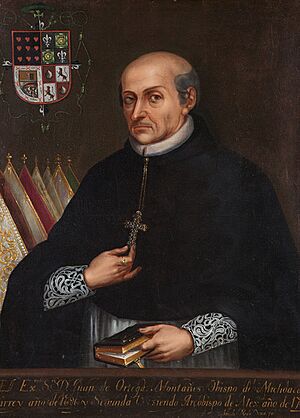Juan Ortega y Montañés facts for kids
Don Juan Ortega y Montañés (born July 3, 1627, in Siles, Spain; died December 16, 1708, in Mexico City) was an important leader in the Roman Catholic Church and a colonial administrator. He served as a bishop in Guatemala and New Spain (which is now Mexico).
He was a bishop in different places:
Later, he became the archbishop of Mexico from 1700 until his death in 1708. He also acted as the temporary viceroy of New Spain twice. A viceroy was like a governor who ruled a colony in the name of the king or queen. His first time as viceroy was from February to December 1696. His second time was from November 1701 to November 1702.
Early Life and Church Work
Juan Ortega y Montañés was born in Cartagena, Spain. He studied in Cartagena, Málaga, and Alcalá de Henares. He earned a special degree in law. He then became an inquisitor in New Spain. An inquisitor was a church official who investigated people accused of not following church rules.
He was known for being against church leaders who misused their power. He also believed that priests should live simply and humbly. People respected him for his kindness, his care for the people in his church, and his hard work.
First Time as Viceroy
In February 1696, Ortega y Montañés became the temporary viceroy of New Spain. He took over from the previous viceroy, Gaspar de la Cerda.
One of his first challenges was dealing with a student protest. On March 27, 1696, university students tried to burn a scaffold in the main square. They saw it as a symbol of the king's power. This caused a lot of worry in Mexico City. Police stopped the protest and arrested a student. Other students tried to free him by throwing rocks at the police.
Another important event during his first time as viceroy was sending a group of Jesuit priests to California. Their goal was to teach Christianity and help settle the area. Famous missionaries like Father Eusebio Kino and Father Juan María Salvatierra were part of this group. They started a fund to help with the colonization work.
A new viceroy took over in December 1696. Bishop Ortega y Montañés then went back to his church duties in Michoacán. He stayed there until March 1700, when he became the archbishop of Mexico.
Second Time as Viceroy
In March 1701, news arrived that King Charles II of Spain had died. The king had no children to take his place. This led to a big war called the War of the Spanish Succession. This war was fought to decide who would be the next king of Spain.
The viceroy at that time supported a different family for the throne. Because of this, he was removed from his job. Juan Ortega y Montañés was once again chosen to be the temporary viceroy.
While he was serving as viceroy, he officially became the archbishop of Mexico in January 1702. He was very devoted to the Virgin of Guadalupe, who is a special patron of Mexico. The church built in her honor was finished during his time as viceroy in 1702. He even traveled around asking for donations to help finish the building.
He also stopped the practice of sending prisoners from New Spain to Puerto Rico. His predecessor had started this.
Later, the viceroy learned that a French fleet had arrived in Havana. They wanted to take money and goods from New Spain to France. Viceroy Ortega asked his advisors what to do. They decided not to give the tribute to the French without direct orders from the Spanish king.
On November 18, 1702, Archbishop Ortega left Mexico City. He went to welcome the new viceroy and hand over his power.
Ortega y Montañés died in 1708, still serving as the archbishop of Mexico. He wrote several documents, including a report about the state of the colony.
See also
 In Spanish: Juan de Ortega Montañés para niños
In Spanish: Juan de Ortega Montañés para niños


